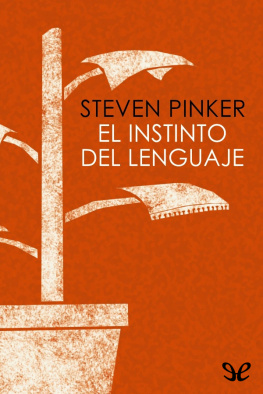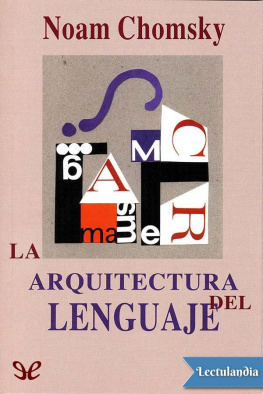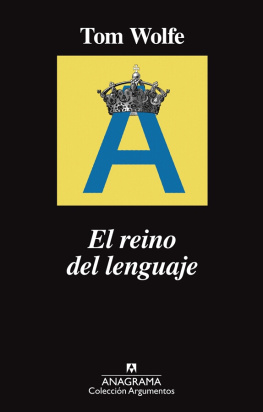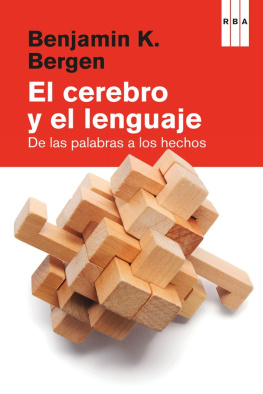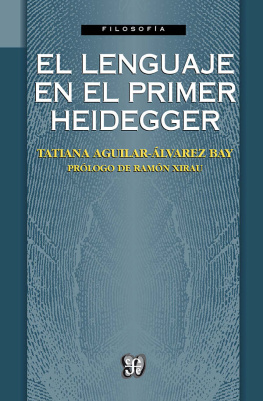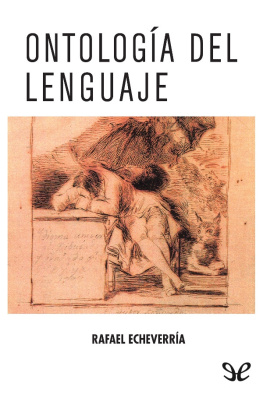
STEVEN ARTHUR PINKER (Montreal, 18 de septiembre de 1954). Es un psicólogo experimental, científico cognitivo, lingüista y escritor canadiense. Es conocido por su defensa enérgica y de gran alcance de la psicología evolucionista y de la teoría computacional de la mente. Sus especializaciones académicas son la percepción y el desarrollo del lenguaje en niños, es más conocido por argumentar que el lenguaje es un “instinto” o una adaptación biológica modelada por la selección natural.
Obras: El instinto del lenguaje: cómo crea el lenguaje la mente (1994). Cómo funciona la mente (2001). Tabula rasa: La negación moderna de la naturaleza humana (2002). El mundo de las palabras (2007). Los ángeles que llevamos dentro: El declive de la violencia y sus implicaciones (2011).
BIBLIOGRAFÍA
Abler, W. L. (1989). «On the particulate principle of self-diversifying systems». Journal of Social and Biological Structures, 12, 1-13.
Aitchison, J. (1991). Language change: Progress or decay? (2a ed.). Nueva York: Cambridge University Press.
Allen, W. (1983). Without feathers. Nueva York: Ballantine [hay ed. cast.: Cuentos sin plumas. Barcelona: Tusquets, 19S9].
Ammerman, A. J., y Cavalli-Sforza, L. L. (1984). The neolithic transition and the genetics of populations in Europe. Princeton: Princeton University Press.
Anderson, J. R. (1990). The adaptive character of thought. Hillsdale, New Jersey: Erlbaum.
Aronoff, M. (1976). Word formation in generative grammar. Cambridge, Massachusetts: MIT Press.
Aronoff, M. (1987). Review of J. L. Bybee’s «Morphology: A study of the relation between meaning and form». Language, 63, 115-129.
Atran, S. (1987), Folkbiological universals as common sense. En Modgil y Modgil (1987).
Atran, S. (1990), The cognitive foundations of natural history. Nueva York: Cambridge University Press.
Au, T. K.-F. (1983). «Chinese and English, counterfactuals: The Sapir-Whorf hypothesis revisited». Cognition, 2J, 155-187.
Au, T. K.-F. (1984). «Counterfactuals: In reply to Alfred Bloom» Cognition, 17, 289-302.
Baillargeon, R. (en prensa). «The object concept revisited: New directions in the investigation of infants’ physical knowledge». En C. Granrud (Ed.), Visual perception and cognition in infancy. Hillsdale, New Jersey: Erlbaum,
Bamberg, P. G,, y Mandel, M. A. (1991). «Adaptable phoneme-based models for large vocabulary speech recognition». Speech Communication, 10, 437-451.
Barkow, J. H. (1992). «Beneath new culture is old psychology: Gossip and social stratification». En Barkow, Cosmides y Tooby (1992).
Barkow, J. H., Cosmides, L., y Tooby, J. (Eds.) (1992). The adapted mind: Evolutionary psychology and the generation of culture. Nueva York: Oxford University Press.
Basso, A.; Lecours, A. R., Moraschini, S., y Vanier, M. (1985). «Anatomoclinical correlations of the aphasias as defined through computerized tomography: Exceptions», Brain and Language, 26, 201-229.
Bates, E.; Thal, D. y Janowsky, J. S. (1992), «Early language development and its neural correlates». En 1. Rapin y S. Segalowitz (Eds.), Handbook of neuropsychology, Vol. 6: Child neurology. Amsterdam: Elsevier.
Bates, E.; Thai, D,, y Marchman, V. (1991). «Symbols and syntax: A Darwinian approach to language development». En Krasnegor et al., (1991).
Baynes, K., e Iven, C. (1991). «Access to the phonological lexiconin an aphasic patient», Comunicación presentada en la reunión anual de la Academy of Aphasia.
Belliveau, J. W.; Kennedy, D. N.; McKinstry, R. C.; Buchbinder, B. R.; Weisskoff, R. M.; Cohen, M. S.; Yevea, J. M.; Brady, T J., y Rosen, B. R. (1991). «Functional mapping of the human visual cortex by Magnetic Resonance Imaging». Science, 254, 716-719.
Bellugi, U.; Bihrle, A.; Jemigan, J,; Trauner, D., y Doherty, S. (1991), «Neuropsychological, neurological and neuroanatomical profile of Williams Syndrome». American Journal of Medical Genetics Supplement, 6, 115-125.
Bellugi, U.; Bihrle, A.; Neville, H.; Doherty, S., y Jemigan, J. (1992)'. «Language, cognition and brain organization in a neurqdevelopmental disorder». En M. Gunnar y C. Nelson (Eds.), Developmental behavioral neuroscience: The Minnesota Symposia on Child Psychology. Hillsdale, New Jersey: Erlbaum.
Berlin, D.; Breedlove, D., y Raven, P. (1973). «General principles of classification and nomenclature in folk biology». American Anthropologist, 87, 298-315.
Berlin, D.; y Kay, P. (1969). Basic color terms: Their universality and evolution. Berkeley: University of California Press.
Bernstein, T. M. (1977). The careful writer: A modern guide to English usage. Nueva York: Atheneum.
Berwick, R. C. (1985). The acquisition of syntactic knowledge. Cambridge, Massachusetts: MIT Press.
Berwick, R. C.; Abney, S. P., y Tenny, C. (Eds.) (1991). Principle-based parsing: Computation and psycholinguistics. Dordrecht, Holanda: Kluwer.
Berwick, R. C., y Weinberg, A. (1984). The grammatical basis of linguistic performance. Cambridge, Massachusetts: MIT Press.
Bever, T. G, (1970). «The cognitive basis for linguistic structures». En J. R. Hayes (Ed.), Cognition and the development of language. Nueva York: Wiley.
Bever, T. G.; Carrithers, C.; Cowart, W… y Townsend, D J. (1989). «Language processing and familial handedness». En A. M. Galaburda (Ed.), From reading to neurons. Cambridge, Massachusetts: MIT Press.
Bever, T. G., y McElree, B. (1988). «Empty categories access their antecedents during comprehension». Linguistic Inquiry, 19, 35-45.
Bickerton, D., (1981). Roots of language, Ann Arbor, Michigan: Karoma.
Bickerton, D., y comentaristas (1984). «The language bioprograra hypothesis». The Behavioral and Brain Sciences, 7, 133-221.
Bickerton, D. (1990). Language and species. Chicago: Chicago, University Press [hay ed. cast.: Lenguaje y especie. Madrid: Alianza Editorial, 1994].
Bickerton, D. (1992). «The pace of syntactic acquisition». En L. A. Sutton, C. Johnson, y R. Shields (Eds.), Proceedings of the 17th Annual Meeting of the Berkeley Linguistics Society: General Session and Parasession on the Grammar of Event Structure. Berkeley, California . Berkeley Linguistics Society.
Birdsong, D. (1989). Metalinguistic performance and interlinguistic competence. Nueva York: Springer.
Bishop, D. V. M., North, T., y Donlan, D. (1993). Genetic basis for Specific Language Impairment: Evidence from a twin study. Manuscrito no publicado, Medical Research Council, Applied Psychology Unit, Cambridge, Reino Unido.
Bley-Vroman, R. (1990). «The logical problem of foreign language learning». Linguistic Analysis, 20, 3-49. Bloom, A. H. (1981). The linguistic shaping of thought: A study of the impact of language on thinking in China and the West. Hillsdale, New Jersey: Erlbaum.
Bloom, A. H. (1984). «Caution - the words you use may affect what you say: A response to Au». Cognition, 17, 275-287.
Bodmer, W. F., y Cavalli-Sforza, L. L. (1970). «Intelligence and race». Scientific American, octubre.
Bolinger, D. (1980). Language: The loaded weapon. Nueva York: Longman.
Botha, R. P. (1989). Challenging Chomsky. Cambridge, Massachusetts: Blackwell.
Bouchard, T. J., Jr.; Lykken, D. T.; McGue, M.; Segal, N. L., y Tellegen, A. (1990). «Sources of human psychological differences: The Minnesota study of twins reared apart».

